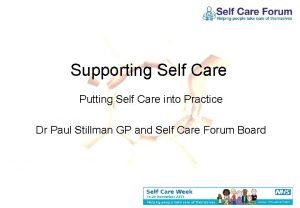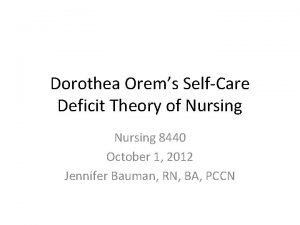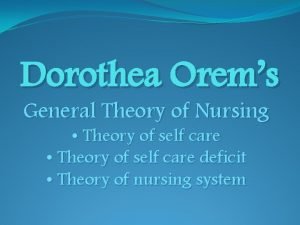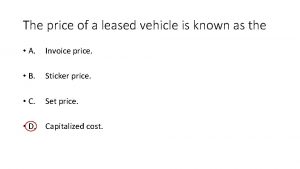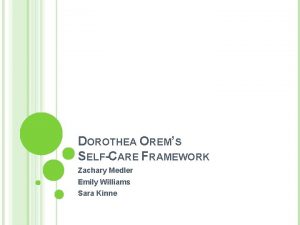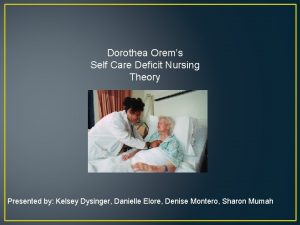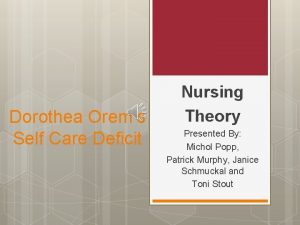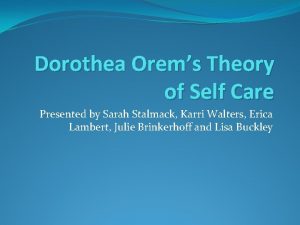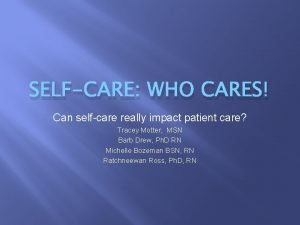Orems SelfCare Theory in the Nursing Practice Timothy









- Slides: 9

Orem’s Self-Care Theory in the Nursing Practice Timothy Carlson Martin Isenhart Alyssa Pechta Mackenzie Tunney Ryan Walters Ferris State University

Orem’s Self-Care Theory in the Nursing Practice Dorothea Orem constructed her Self-Care Theory concept in the late 1950’s § Developed the Self-Care Theory to help encourage individuals to play an active role in their own care (Black, 2014) § Purpose Statement: § Self-Care Theory contributes to positive patient outcomes by: • Utilizing evidence-based practice to improve the quality of care • Understanding the four metaparadigm concepts • Improving health care practices on multiple levels

Evidence-Based Practice Theory in Evidence Based Practice (EBP) § Theory and science are necessary and linked parts (Taylor & Renpenning, 2011) § Foundation for evidence-based practice § Theory offers a framework to guide practice and education (Murphy, Williams, & Pridmore, 2010) § Theory in nursing includes concepts, methods, and principles § Nursing research validates nursing theory and leads to EBP (Taylor & Renpenning, 2011) § Provides knowledge for improved practice, guides research and curriculum, and identifies the goals of nursing practice (Stevens, 2013) § Theory-guided, EBP is the hallmark of the nursing profession (Stevens, 2013)

Metaparadigm Concepts Self-Care Theory Metaparadigm: § Nurses should only do for the patients what they cannot do for themselves (Simmons, 2009) § Patients actually want to care for themselves (Simmons, 2009) § Self-Care Theory’s relationship among four concepts: • Person, environment, health, and nursing Person § Has capacity for self knowledge, learning, and development (Simmons, 2009) § Can learn to meet self care needs (Masters, 2013) Environment § Person and environment are reciprocal (Masters, 2013) § Person is never separate from the environment § Physical, biological, chemical, and social (Masters, 2013)

Metaparadigm Concepts Health § Functions of daily living § Progressive development to a higher level of functioning (Masters, 2013) Nursing § Assisting patients in the development, delivery, and management of self-care (Simmons, 2009) § Preserve some level of effective functioning (Masters, 2013) • Wholly Compensatory • Partly Compensatory • Supportive Education System q. The goal is to let the patient achieve an optimal level of self-care

Contemporary Health Care Environment Self-Care Theory and Improving Health Care § On a local, regional, and global level Orem’s theory provides common language in self-care (Green, 2013) § Local: Increases self-care abilities of the individual (Bhanji, 2012) § Health prevention, promotion, and maintenance (Bhanji, 2012) § Take responsibility § Political agendas: Local, regional, and global § Educating on health promotion, prevention, and maintenance can decrease spending costs to everyone § Flexible framework (Green, 2013) § Community and public health nursing: Local and regional (Green, 2013)

References Bhanji, S. M. (2012). Comparison and contrast of Orem’s self care theory and Roy’s adaption model. Journal of Nursing, 1(1), 48 -53. Retrieved from http: // www. zu. edu. pk /images/pdf/journal_nursing/Journal%20 of%20 Nursing %202012, %20 Vol%20%201%20(01)%204853. pdf Black, B. P. (2014). Professional nursing: Concepts and challenges (7 th ed. ). Maryland Heights, MO: Saunders. Green, R. (2013). Application of the self care deficit nursing theory: The community context. Self-Care, Dependent-Care & Nursing, 20(1), 5 -15. Retrieved from http: //www. orem-society. com /images/ publication/ journal/Vol 20 No 01 Spring 13. pdf Masters, K. (2013). Role Development in Professional Nursing Practice (3 rd ed. ). Sudbury, MA: Jones and Bartlett Publishers, Inc.

References Murphy, F. , Williams, A. , & Pridmore, J. A. (2010). Nursing models and contemporary nursing 1: Their development, uses, and limitations. Nursing Times, 106(23), 18 -20. Retrieved from http: //www. nursingtimes. net/Journals/ 2013/01/18/c/m/m/ 100615 Practice-in-depth-Nursing-models-andcontemporary-nursing--1 --their-development-uses-and-limitations. pdf Simmons, L. (2009). Dorothea Orem’s self care theory as related to nursing practice in hemodialysis. Nephrology Nursing Journal 36(4), 419 -420. Retrieved from http: //go. galegroup. com/ps/i. do? id=GALE%7 CA 206850790&v=2. 1&u=lom _ferrissu&it=r&p=ITOF&sw=w&asid=5 c 580606076 c 420 ca 90 ba 70900 d 3 c 2 ef .

References Stevens, K. R. (2013). The impact of evidence-based practice in nursing and the next big ideas. The online Journal of Issues in Nursing, 18(2). Retrieved from http: //www. nursingworld. org/Main. Menu Categories/ANAMarketplace/ ANAPeriodicals/OJIN/Tableof. Contents/Vol-18 -2013/No 2 -May-2013/Impact-of. Evidence-Based-Practice. html Taylor, S. G. , & Renpenning, K. (2011). Self-care science, nursing theory, and evidencebased practice. New York, NY: Springer Publishing Company .

